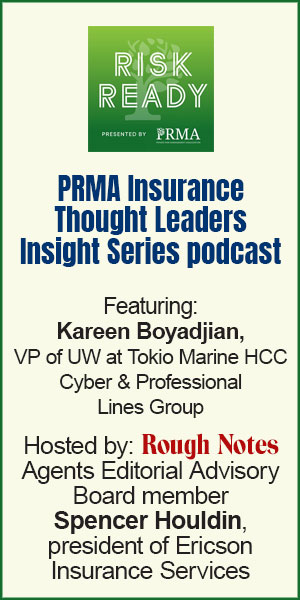Young Professionals
PROSPECTING: PART ONE
Tips for searching for potential customers
By Christopher W. Cook
The other day—a phrase I loosely use to refer to any date between yesterday and sometime within the past three or so years—I sent members of my young professional networks a survey regarding potential topic ideas for this feature. A handful responded with “prospecting.” Unfortunately—although the definition of prospecting also refers to it—we won’t be providing tips on how to find mineral deposits, particularly gold, which if found could help fund an early retirement. Womp womp. But we will be sharing strategies on searching for potential customers.
Earlier this year, in February to be exact (“earlier this year” is not to be confused with “the other day”), I attended the Michigan Association of Insurance Agents (MAIA) conference, where Joan Sansing, CIC, ARM, AAI, president of Sansing Consulting, Inc., led a session titled Marketing for Success, in which she shared a plethora of tips on prospecting. In fact, we’ll need two installments to cover all the information.
“Everybody is a suspect, but not everyone is a prospect. If everyone is your target market, then no one is your target market.”
—Joan E. Sansing, CIC, ARM, AAI
President
Sansing Consulting, Inc.
First and foremost, the art of prospecting comes down to preparation. Tom Hopkins, author, entrepreneur and speaker, once said, “Preparation is the key to winning in negotiations, persuading others, and selling products and services.” You have products and services to offer, but you need to find people to persuade in order to win the negotiations. Where do you begin?
Finding prospects
Who are your prospects, and how do you find them?
“Everybody is a suspect, but not everyone is a prospect,” Sansing said. “If everyone is your target market, then no one is your target market.”
A prospect can be described as someone who knows you or knows of you and could be interested in doing business with you in the future.
There are numerous ways to find these individuals or companies for free, but purchasing prospect lists through websites like Dun & Bradstreet (D&B) Hoovers, Salesgenie and InfoUSA is always an option.
Another option, ReferenceUSA, is available at most public libraries. While you used to have to physically go to the library to use the business and residential research site, it now may be available through your library’s website or app. The site provides historical market trends and company locations, business executives’ contact information and related news articles.
The website First Research, another D&B company, allows users to better understand a prospect’s or client’s business issues by sharing quarterly industry updates. Reports—including employment data and local real estate information, among others—on individual U.S. states and Canadian provinces are also available for a fee.
When using a purchased prospect list, add filters on your searches—e.g., territory, amount of sales, number of employees—to narrow down your list of results. Not all prospecting lists cost money. Membership directories can be obtained from people who belong to groups like trade associations, unions, fraternal organizations, religious entities, country clubs and political groups.
Additional sources for prospects include:
- Acquaintances
- Alumni associations
- Chamber of Commerce
- City directories
- College yearbooks
- Company telephone directories
- Hobby clubs
- Neighbors
- Referrals
- Relatives
- Spouse’s contacts
- Voter registration lists
Another good research tool is a website that you may check on a regular basis—LinkedIn. When setting up your profile on the site, be sure to include as many specific words or phrases as possible, such as risk manager, employee benefits, property and casualty, or commercial insurance. This allows potential prospects searching for an agent to find you when initiating their searches.
“Are your prospects and current clients in private groups on your LinkedIn page, or are they all lumped together?” asked Sansing. You would like your prospects and clients to be private so your competition cannot view them. Another LinkedIn tip she shared: “We ask each of our producers at the end of the year to take their top 50 prospects and search their company profiles on LinkedIn to see who else works there.” A quick company search can identify your prospects’ coworkers, their job titles, and work histories.
To keep track of your prospects, once you’ve found them, Google Alerts allows you to be informed by email if names or companies appear in media coverage, press releases or blog posts. “I want to know what’s going on with my clients and prospects so I can be the first person to reach out to them, especially when something positive has happened,” said Sansing.
Emailing tips
Now that we’ve discussed where to find prospects, let’s talk about methods to reach out to them. Is emailing better than calling on the phone, since there’s the possibility that you’ll have to leave a voice message? Do Baby Boomers prefer one method and Millennials the other? And let’s throw texting into the mix. Regardless of one’s personal communication preference, email is still an option used by many.
When you’re sending a business communication, it should come from your company’s domain and not from one of your personal email addresses. If you’re sending a message from your smart phone, remove any “extras” like graphics, pictures or wallpaper backgrounds.
Your message itself should be brief—fewer than 150 words or two to three paragraphs—and to the point. Stay away from using ALL CAPS, boldface and acronyms. Your message should have a relevant subject line and a brief signature line and should not discuss coverage or pricing on your initial approach.
Speaking of subject lines, beware of “salesy” words not to use. According to media company Real Magnet, Inc., the following words used in a subject line are the ones most likely to send the message into a spam folder: Advertisement, Cash, Cheap, Congratulations, Credit, Deal, Discount, Free, Guarantee, Income, Investment, Marketing, Money, Obligation, Offer, Opportunity, Price, Profit, Promotion, Refund, Sales, Save, Shop, Win, Winner, Winning, Won.
What if you need to email someone and you don’t have the address? Sometimes Google searches turn up blanks, and certain information is withheld on some company websites.
Sansing explained that “there are four primary ways of setting up an email address in a corporation”:
- First name@company.com
- First name (period) last name@company.com
- First name last name@company.com
- First initial last name@company.com
 Websites like https://hunter.io/ can also be used to discover a company’s email address format—if it shows up on the site. Verify-email.org is another tool that can be used to verify whether a given address is legit or not.
Websites like https://hunter.io/ can also be used to discover a company’s email address format—if it shows up on the site. Verify-email.org is another tool that can be used to verify whether a given address is legit or not.
In the next installment, we’ll discuss everyone’s favorite: cold calling. Until then … keep searching for that gold.






